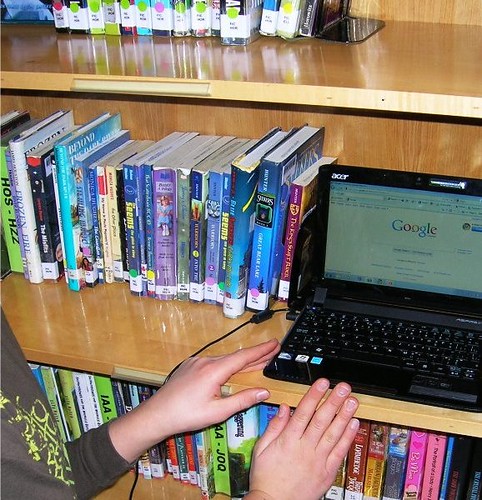Invicta Grammar school is an 11–18 selective girls’ school with a mixed a Sixth Form. With Valley Park School it is part of the Valley Invicta Academies Trust. There are 1251 students on roll, including 371 in the Sixth Form, with just under 3% of students eligible for free school meals.
 Netbook Shelf, by Enokson http://www.flickr.com/photos/vblibrary/Describing itself as a networked school, ie one in which the staff has normalised the use of the digital in their everyday teaching and is collaborating authentically with parties outside the school walls and professional teachers in the teaching of the young, Invicta has established a system which ensures that each student has a device when and where they need it. However, and interestingly, this has not been achieved through a Bring Your Own Device (BYOD) scheme alone, but through the development of what we might call an entire ecosystem of technology, developed over several years.
Netbook Shelf, by Enokson http://www.flickr.com/photos/vblibrary/Describing itself as a networked school, ie one in which the staff has normalised the use of the digital in their everyday teaching and is collaborating authentically with parties outside the school walls and professional teachers in the teaching of the young, Invicta has established a system which ensures that each student has a device when and where they need it. However, and interestingly, this has not been achieved through a Bring Your Own Device (BYOD) scheme alone, but through the development of what we might call an entire ecosystem of technology, developed over several years.
In Years 7 to 9, ie the first three years of the students’ school career, pupils can buy netbooks and laptops, either through the school, which also runs an e-Learning Foundation (ELF) scheme, or from another source. (The ELF scheme is one on which parents make donations to the charity and receive in return a supported loan device over a period of time.)
In Years 10-13, students can bring in their own device. In this context, “device” means a netbook or a laptop, not a smartphone. Whilst an i-Pad trial is underway, Apple devices are not yet fully supported.
It is difficult to measure the impact of the BYOD scheme because technology is so firmly embedded in the school’s life. All staff have laptops, and there are interactive whiteboards and projectors in every classroom. In addition, laptops can be borrowed by students if necessary. Moreover, the school’s virtual learning environment is available to students and staff 24/7 from home as well as school, and this contains all the resources used in lessons.
In reality, the BYOD scheme implemented by Invicta is a hybrid of school-supplied or specified technology for the younger students, and a true BYOD scheme, within certain limits, for the older ones.
The question arises, why have a 1-to-1 scheme given the fact that there is so much technology in the school already?
Carol Webb, Assistant Headteacher, explains:
“The versatility of having a tool in the classroom to use as and when it’s needed to support learning is a huge benefit. With the e-learning foundation scheme we are able to provide a loan device when the technology goes wrong and requires maintenance, which ensures that teaching and learning are not interrupted. Staff know that every student in Years 7-9 has reliable technology and can bring it to a lesson. This makes planning lessons easier.”
One thing which is clear from Invicta’s experience is that it’s crucial that the school’s educational vision, strategy and ethos supports such developments – they cannot happen in a vacuum.
However, there are practical challenges to be met in introducing a BYOD programme. Carol identifies the following crucial factors:
- Senior Leadership Team support
- Parental engagement
- A strong ICT and ICT support team
- Sustainable site-wide wireless access
- Constant planning and evaluation.
So what’s next for Invicta? The school is looking into the possibility of using more web-based applications. With students able to have access to a device and to the school’s Virtual Learning Environment constantly, this makes a great deal of sense, and will only serve to embed technology in the life of the school even more deeply.
Fuller details on the school can be found at: Invicta Grammar School.
